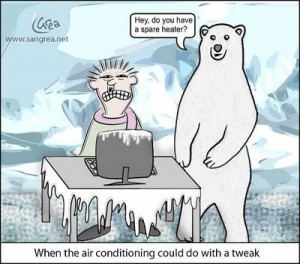 I thought I had done the best I could with optimizing our small server room. We have two rows of server cabinets which hold all of our servers, file systems and management devices. I arranged the cabinets so that both rows had the servers facing toward the aisle between them. My reasoning was that it would be easier for administrators to walk a single aisle to see systems and gain access to the KVM devices. Little did I know back then that this would lead to optimizing the space by creating a cold aisle since all the servers take in air from the front and exhaust out the back.
I thought I had done the best I could with optimizing our small server room. We have two rows of server cabinets which hold all of our servers, file systems and management devices. I arranged the cabinets so that both rows had the servers facing toward the aisle between them. My reasoning was that it would be easier for administrators to walk a single aisle to see systems and gain access to the KVM devices. Little did I know back then that this would lead to optimizing the space by creating a cold aisle since all the servers take in air from the front and exhaust out the back.
Well, we’ve all learned about carbon footprints, green thinking and cost reduction recently. I was talking about this with Bob Gibble, a friend of mine who stopped by a few weeks ago at my office. He builds and designs large data centers and we were chewing the fat about how much A/C I am using in my server room and my ability to expand services is becoming limited. He agreed to take a walk-through and give me some ideas.
He checked my UPS and looked at the load. Using those numbers, he calculated the amount of A/C that should be required. His rough numbers showed that the room should be demanding about 9 tons of A/C. However, I was using 20 tons and it was running 7×24 at full capacity.
So, this is the first in a series or articles about my experiences in decreasing costs, optimizing for expansion and minimizing our carbon footprint.
Fixing The Cold Aisle
The first thing he noticed was my attempt to build hot and cold aisles by changing the duct work in the ceiling. However, he also saw that the grills I was using were intended to be used in general office space and not in a server room. As such, they were aimed down only about 30-degrees instead of straight down. In an office space, this is desirable to prevent freezing the employees who have offices below them, but in a server room, air flow is critical and it needs to get all the way down to the floor.
Bob put his hands above the cabinets and showed me how a lot of my cold air was shooting right over the cabinets into the cold-air returns. Then he put his hand on the floor and no air was getting down there and devices in the lower quadrant of the cabinets were hotter than most. He also noted how loud and fast some fans were running on our servers and BladeCenters. Then he gave me “the look” and I knew I was going to get an education.
He grabbed a ladder and started pulling the 2’x2′ A/C grills out of the ceiling, letting the air just dump straight down. Almost immediately, I could feel the temperature in my cold aisle drop a few degrees and I could feel air around my ankles. After about an hour, I went to my MRTG graphs that we keep on the temperature sensors of certain critical devices. They all showed a drop of at least 7-10 degrees Fahrenheit. We had our A/C company install new grills that allows for variable direction, but for the aisle, they point straight down.
Racks and UPS
The racks in the room have routers, switches, firewalls and patch panels. None of these are generating that much heat and our three Cisco 6509’s have about 12 fans that blow to their side. Yet again, our old grills was pushing air over the racks and missing the hardware. We aimed a new grill to hit the lowest device in the racks and closed off half of the other one as it was cooling an empty and unused part of the room.
The UPS vents its heat to the top and that is where our old grille was aimed. Very inefficient as we were blowing cold air at the exhaust and sending it all to the cold air return. We aimed a new grill at the floor intake of the UPS.
Results
We continued to monitor the temperature sensors and other statistics and this really made a difference. Out two-stage A/C unit could actually shut one stage down for awhile as the demand for cold air was being reduced. The fans in some servers slowed down by as much as 15-20 percent now that they had ample cold air. The cold-air aisle is colder and the ambient room temperature is lower overall.
This server room is over 8 years old and was already built before our company occupied the building. Unfortunately, they did not install variable fans in the roof-mounted A/C unit and retrofitting that is probably not cost-effective as the ROI might be as much as 4-5 years. However, it is under consideration.
I have now hired Bob as a part-time consultant to help us improve the efficiency of the server room and decrease costs.
In my next article, I’ll talk about reducing waste by closing up those holes in the cabinets.
Related articles by Zemanta
- Pixar Animation Chills Out Its Server Room (datacenterknowledge.com)

![Reblog this post [with Zemanta]](http://img.zemanta.com/reblog_e.png?x-id=a30c4771-e3fb-4622-9fd8-7cdcde7e3f64)

Pingback: Two types of refrigerator | Freezer types |()
Pingback: Building a Green Server Room – Push Air Where You Need It()